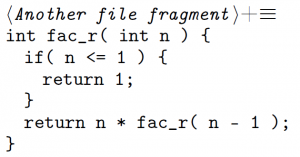Today, I want to release another bit of code from my master’s thesis. However, this time it won’t be C++ code, instead I’m going to release some LaTeX code which I used to display source code fragments with.
Specifically the results look like this:
You can download the accompanying example PDF here.
This mirrors the style of PBRT, which uses literate programming to develop and explain an advanced raytracer. Only it doesn’t require you to write source code that adheres to literal programming principles. I used it to take parts of the source code of my master’s thesis and explain them.
The following LaTeX code is used to create the fragment above:
\defTaggedCurrentFileFragment<Another file fragment;recursive>+=You can either inline code fragment using a special listing environment, or you can reference code fragments in an external file.
//<Another file fragment;recursive> =
int fac_r( int n ) {
if( n <= 1 ) {
return 1;
}
return n * fac_r( n - 1 );
}Cross-referencing is allowed as well and forward page references are created just like in PBRT. However, I have not figured out how to create backward references.
You can find the LaTeX code on GitHub. I have not wrapped it into a LaTeX package because I don’t consider it mature enough, but maybe someone finds it useful, and it eventually ends up in a package (that would be neat :)).
To close, I want to say that the book More Math into LaTeX1 has been very useful while creating these LaTeX macros. It is the first book that covers creating custom macros and commands understandable and in-depth. It feels good to finally understand a bit more about how you can customize LaTeX to fit your needs :)
Cheers,
Andreas
